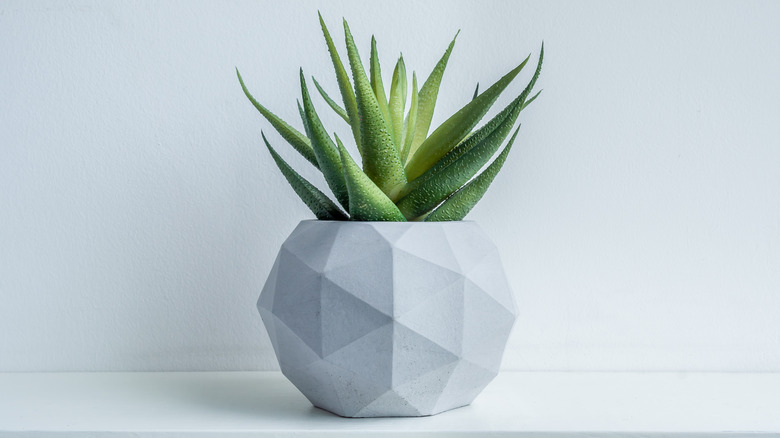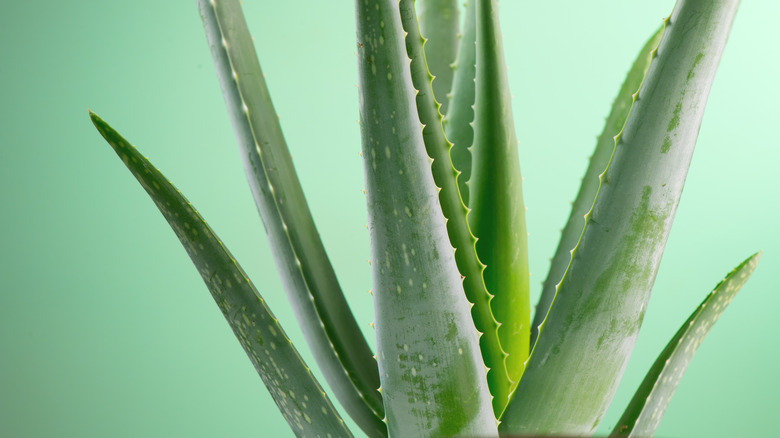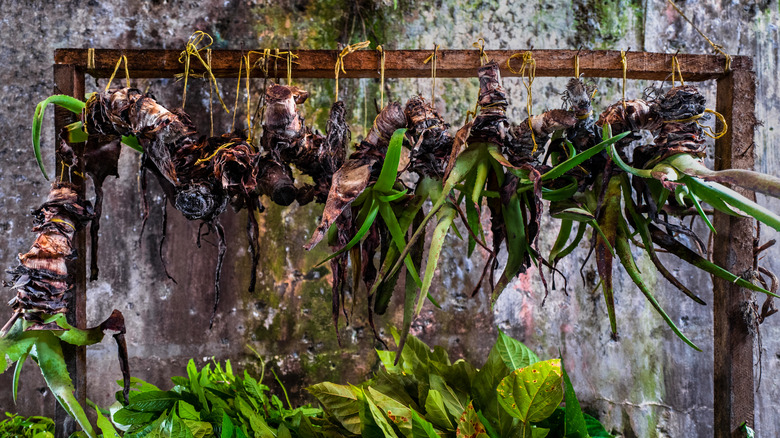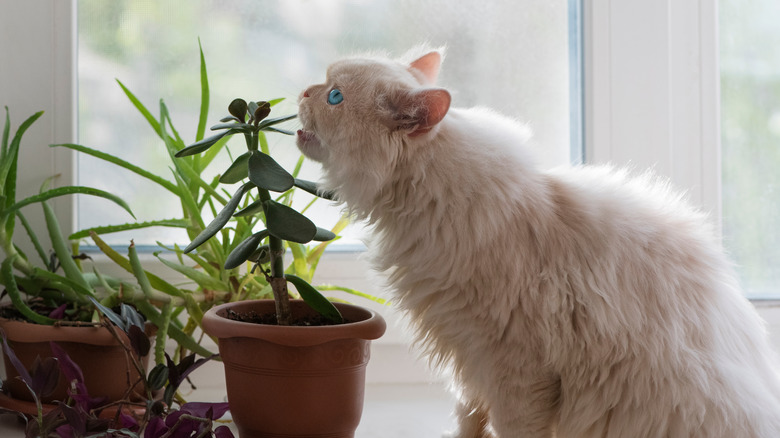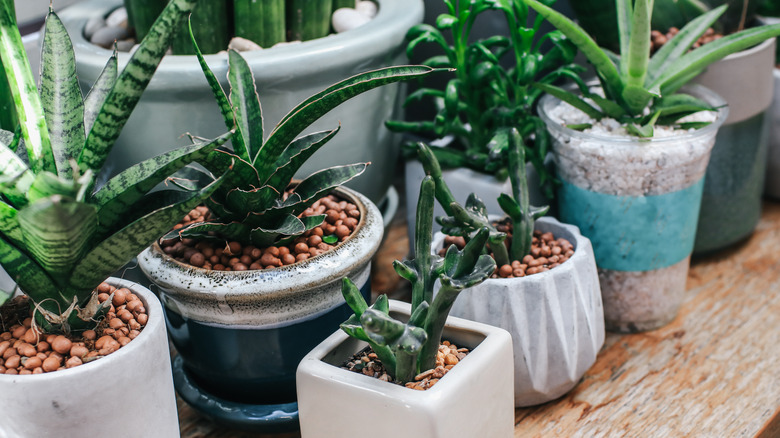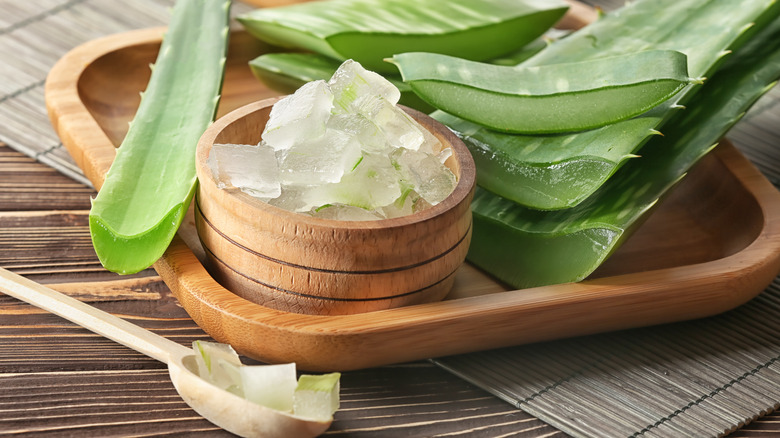How To Correctly Grow And Take Care Of Aloe Vera Plants
Aloe barbadensis miller is a common household plant with a long history of healing. The aloe is a pretty hardy plant, but it has a temperamental side when it comes to giving it the proper care and attention. The Old Farmer's Almanac points out that it is important to ensure you have the right spot for your aloe, as it needs indirect sunlight for optimal growth. When in direct sunlight, the aloe risks drying out and yellowing
Aloe vera plants are very recognizable by their fleshy, thick green "leaves" (though they don't resemble traditional leaves). These big, chunky stalks come out from the base of the plant. Each of the leaves is serrated, with little bumps on the edges. The plant somewhat resembles a style of cactus, but it's not prickly. Aloes are succulents, a type of plant that stores water in its leaves or stem and includes a wide variety of plants, like cacti.
How to grow aloe vera
When you invest in an aloe plant, you want to ensure that it is in the correct container and the proper soil. Aloe plants, because they are succulents, thrive in soil that drains well. Fortunately, you can buy soil that is specifically made for succulents or cacti. Consider, if you can't find suitable soil, using some stones in the bottom of the pot or using a flower pot with plenty of drainage holes in the bottom.
If your aloe vera plant seems to be filling its pot, it's time for a bigger home. Aloe plants also sprout new "babies" that can be transplanted into their own pot directly, no propagating in water needed. They'll begin to root on their own. Aloe plants also don't need fertilizer; Plant Hardware says that if you want to feed your aloe, only do it once a year and don't use full-strength fertilizer.
How to care for aloe vera
There are a couple of essential things to be aware of when taking care of an aloe vera plant. The first is ensuring that your aloe is getting enough light, but not too much. The key to proper lighting is to put the aloe in indirect or artificial light. Too little light and your aloe may not thrive; too much light and it can start to turn brown or yellow.
It's important not to overwater your aloe. Gardening Know How covers what to look for in over- or under-watering your aloe vera. Signs of too much water include water-filled blisters, blackening of the leaves, and even mold in the soil. On the other hand, too little water shows when the aloe starts to look puckered, and the leaves may start to get yellowish. Aloes only need to be watered every two to three weeks and greatly benefit from a drainage system that keeps them from sitting in standing water.
When you water your aloe, rather than using a watering can, run water evenly into the pot direct from the faucet, letting the water fully drain before putting your plant back. This gives the plant a nice "rain shower" watering.
Varieties of aloe
According to Garden Lovers Club, while aloe barbadensis miller is the most common household variety of aloe, there are around 580 species. However, not all of them are known for their healing properties. Additionally, aloe plants thrive best in USDA zones 8 to 11, and most of them prefer only partial sunlight as opposed to full sun.
Many of the other aloe species are used in landscaping rather than potted as houseplants. Some popular yard aloes include Aloe Crosby's prolific, Arabian Aloe, and Aloe arborescens. Arabian Aloe survives drought and is a hardy groundcover. Many species of aloe, including Aloe marlothii and Aloe broomii, grow well in rocky beds and gravel, without much dirt.
The different varieties of aloe plants vary in color. While most of them are green, there are some with reddish hues and purple colors. In addition, each flowers a bit differently, some with red sprouts that somewhat resemble cattails and others with long orange "berries."
Is aloe vera toxic?
While humans can safely ingest aloe vera in small quantities for healthful benefits without issues, it's important to keep your aloe plants out of the reach of your pets and children. The reason? Aloe plants are toxic to dogs and cats, according to ASPCA. Signs that your pet may have gotten into your aloe plant include vomiting and diarrhea. To verify aloe poisoning, check your plants for missing leaves and chew marks, and call your emergency veterinarian immediately.
The Mayo Clinic suggests not to give oral treatments of aloe to children under 12. In higher doses it can be toxic even to adult humans. If you take too much aloe, it can lead to abdominal pain and diarrhea, and it may cause kidney damage with prolonged use. There's also a chance that cancer can develop with prolonged use. When using it orally, only take it for short periods of time.
How to repot aloe vera
Gardening Know How suggests repotting your aloe vera when it starts to get crowded in its current pot. If your aloe plant has a lot of runners or babies growing off the main plant, repotting offers a great time to separate them and propagate them into their own pots. For repotting, you'll need soil for succulents, a pot with good drainage, and smaller pots for transplanting runners.
Unless your plant is rootbound, it should be easy to remove it from the pot and gently dust the dirt off. If your plant is rootbound, it's OK to cut it out of the pot. Cut the babies from the main plant, and then let the plants sit overnight in a cool, dry place where they can heal.
You can directly transplant the main plant into the new pot with fresh soil. For the babies, you can plant them directly into their new pots, according to Martha Stewart. They will begin to sprout roots and take hold without starting in water alone.
Health benefits of aloe vera
Aloe vera gel is a traditional treatment for skin irritations. During the summer, you can find it on the shelves with sunscreen because it soothes sunburn. You can even purchase aloe drinks that claim to help with digestion and constipation, but avoid eating the aloe gel directly from your homegrown aloe plants, as it can be toxic if you eat too much. It works as a powerful laxative, which is why it's important to be careful with ingestion.
Most often, aloe vera is used topically. It can be used to treat psoriasis, dandruff, acne, and many other skin ailments. WebMD points out that some varieties of aloe vera are safer than others. You can harvest your own aloe gel at home by cutting a leaf off as close to the stem as possible, slicing it open, and removing the gel from inside. Once you puree the gel, you can use it on your skin.
